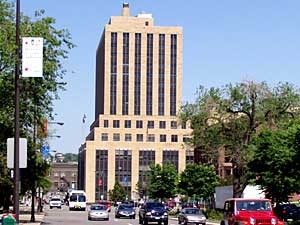|
Audio
Photos
|
June 7, 2005
 |
| The Postal Service's 17-story processing and distribution center sits on the Mississippi River in St. Paul. (MPR Photo/Ted Clement) |
St. Paul, Minn. — The Postal Service's 17-story processing and distribution center sits on the Mississippi River in St. Paul.
It's a sprawling, imposing building that's been standing in the way of big development dreams. Until now.
St. Paul Mayor Randy Kelly says freeing up 12 acres of riverfront property is a boon for the city and region.
"The spinoffs for development will be enormous," Kelly says. "Further riverfront development is certainly something that will be very, very positive."
In addition to the possibilities of redeveloping prime riverfront real estate into housing and retail properties, Kelly says the move permits an important transportation initiative.
The city will be able to expand the attached Union Depot building and convert it back to its original purpose: "a multi-modal transportation hub," Kelly says, "where we can eventually have a terminus for high-speed rail from Chicago and Milwaukee, where we can relocate Amtrak back to downtown St. Paul from the Midway, where we can have light rail transit connecting our capitol city to Minneapolis and the Hiawatha line."
Kelly says the transportation hub would also serve inter-city bus lines and commuter rail.
The U.S. Postal Service will still maintain a retail branch somewhere on the site.
Spokesman Jim Stanley says moving the St. Paul processing and distribution plant to a bulk mail facility in the nearby suburb of Eagan is a matter of efficiency.
He says the 1935 St. Paul building is antiquated because it requires mail to be carried by elevator. He says current mail-processing technology requires a single story facility such as the one in Eagan, which will be expanded to accommodate the operations from St. Paul. Stanley calls the move a "win-win" situation.
"We've been looking for a location for a more efficient processing center," he says. "And the city of St. Paul has been looking to improve the riverfront area and some of the transportation in that area, so I think it's going to work out great for both of us."
And as for Eagan, officials there say they're happy too, for the most part.
The new facility there will be built on the Postal Service's 92 acres of land.
City Administrator Tom Hedges says the city welcomes the prospect of new jobs.
"We've been told the range of new employment for our city is somewhere between about 1,100 and 1,400. That's a nice employment base," he says. "They're good jobs, they're the type of jobs that will certainly help the economy in our community, and the shopping, the retail centers and all of that."
On the other hand, Hedges says, the increased numbers of tractor trailers, postal trucks and employees will put a greater burden on the city's traffic flow. So, Eagan wants the Postal Service to find federal and state money to finance road extensions and improvements.
"We don't feel we're asking for that much in terms of accommodating this," he says. "It's not good planning, it's not resourceful, it's not safe to just put that amount of vehicles, employees, into a location--and we can't fund it ourselves--and have that potential gridlock on our local roads."
U.S. Postal Service officials say they hope to complete negotiations with the cities of St. Paul and Eagan over the next three to four months. The proposal must be approved by the Postal Service's Board of Governors. If all goes according to plan, the move from St. Paul to Eagan would be complete by early 2009.




